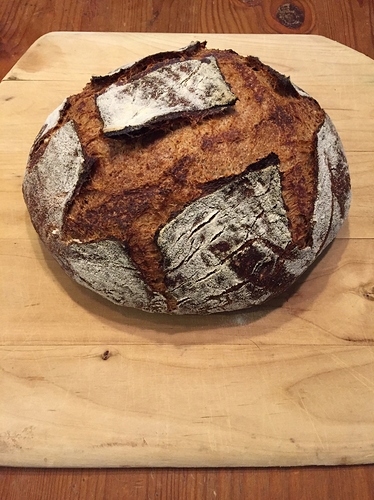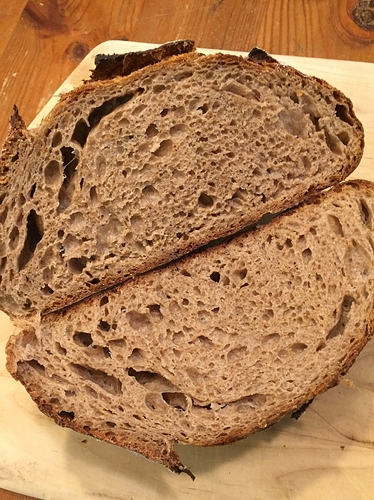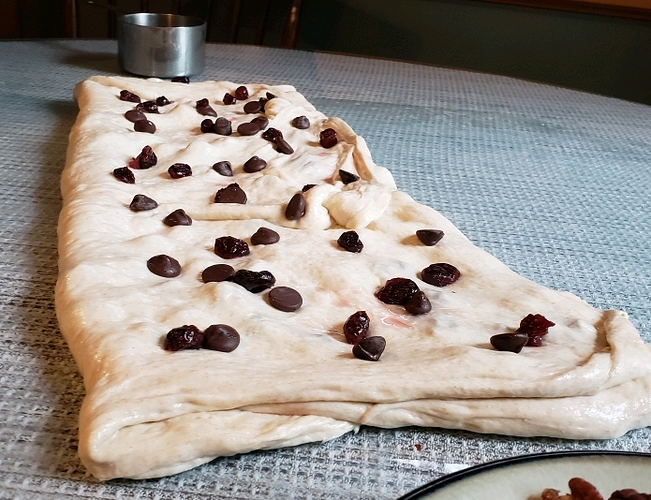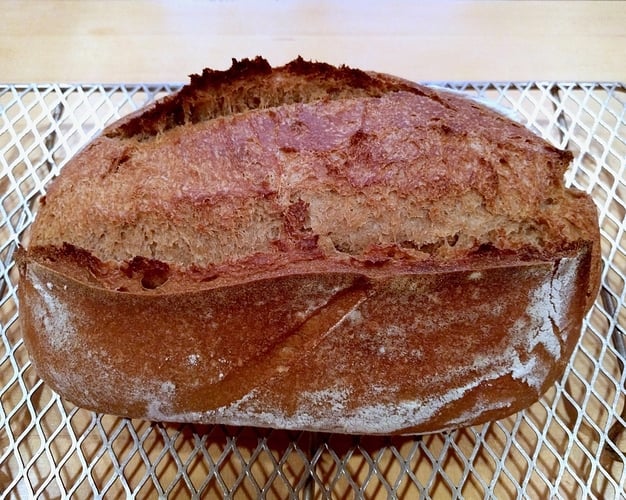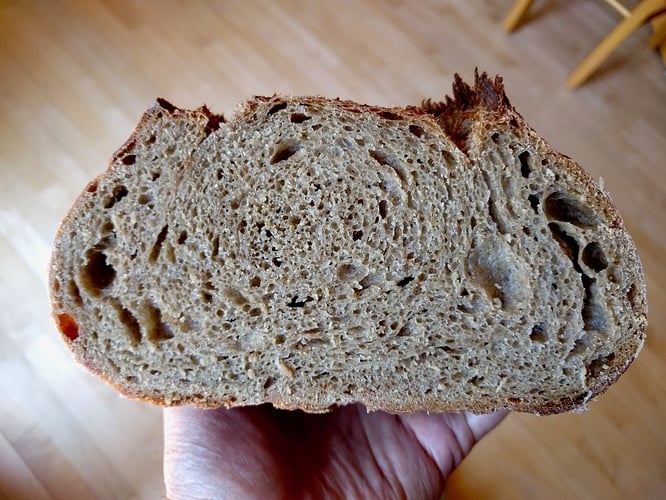I really like this recipe. The dough was…delightful! I did a few things my own way such as shaping. Found the times pretty appropriate with my cold kitchen. I was not thrilled with the baked loaf but I got a professional WW sourdough loaf with my CSA share today and my loaf is actually better! Will be my go to to continue the WW journey. Looking forward to seeing how warmer temps affect the whole thing.
Right?!?!
I love how this dough feels in my hands after 8 - 10 hours or so.
And the flavor of the resulting bread with all that fermentation is really just amazing.
My 2nd try at this. Better than the first even though I felt I was rushing the last few steps a bit.
That looks so good. It makes me want to have a sandwich.
That’s a really nice crumb and great oven spring for a whole grain loaf.
Thank you Paul! Still lots to learn. I feel like I never know what I’m going to find when I lift the cover off the dutch oven haha! But I really like this recipe and will continue to us eat. Thank you for sharing it! p.s. Are you @homebreadbaker on IG?
yup that’s me on IG.
OK, great. I’m @farafieldfarm I love your feed-it’s been super helpful.
Paul, Many thanks for your 100% whole grain post. Many out here are pursuing that Holy Grail of 100%. My typical method is Tartine-style and I’ve obtained very good results at up to 80% whole grain, but no farther. So I tried your method using 75% HR Spring Wheat, 12.5% Kamut, 12.5% Spelt. All of the grain was milled on an 8" stone mill by Meadow Mills, owned by a friend. With that mill, I do have to do a 50-line mesh sift to get out the larger pieces of bran, so I’m fairly sure the flour isn’t nearly as fine as what you are getting from the Mockmill, and that may be the whole difference. (I’m tempted to buy a Mockmill!)
Anyway, the bread I got with your method has incredibly good taste and a great crust, best on both counts for any near-whole grain or whole grain loaves I’ve ever baked. The oven spring and crumb openness were a little disappointing. I usually get >=4" high loaves, these were in the 3" to 3 1/8" range. I followed your timings and went by the indications of the growth in the size of the dough and put the dough in bannetons when the dough was a little more than doubled in size, which happened 4.5 hours into the third phase of proofing. Here’s my main question: The dough seemed quite jelly-like going into the bannetons and was still that way going into the dutch ovens for baking. It did pass Forkish’s finger dent test for readiness. In your view, does that mean I put it in the bannetons too soon or too late? In other words, do you think it was under-proofed or over-proofed? Many thanks again.
Hi Mark.
I’ve read Chad Robertson and watched him on YouTube and used Tartine techniques and recipes and I am a big (huge) fan. But my conclusion after a lot of trying to follow along as carefully as I could, at least for my own baking, is that the magic is in Chad’s hands and not in his written techniques and recipes. I’ve had good results, but not stellar compared with other things I have tried. You can see from the videos in my recipe that the magic is definitely NOT in my hands… (yet).
As it happens, I’ve had experience with the Meadow 8-inch mill and my experience is similar to yours; that’s a pretty coarse milling mill and using its output at 100% whole grain would leave you baking with a lot of very coarse bran. The Mockmill does an amazing job on one pass. You can also sift and then re-mill the tailings to get an even finer finished 100% end result (you could also do this with the meadows, I would imagine). But being lazy and happy enough without any sifting, I’ve just been using one-pass milled flour from the Mockmill.
To your question, unfortunately, it’s pretty hard to diagnose the differences between your dough and mine given that you are using different grains and a different quality of flour. I can say that I’ve had good oven spring results with spelt and not as good, but also not bad results with kamut. Assuming high gluten content of the specific HR you are using, I would think that you’d get a pretty good oven spring and reasonably open crumb with that high a percentage of HR wheat. In my own experience, poor oven spring is nearly invariably the result of me over-proofing. If my interpretation of “jelly-like” matches your use of the words, I’d also think that would be consistent with possible over-proofing. Although it could also be consistent with not enough (or vigorous enough) stretch & folding in the final bulk proofing period and / or not really fully stretching and de-gassing the dough in the shaping / laminating step. My better results have definitely been associated with a much rougher treatment of the dough than you’d ever see Chad doing. First thing I’d probably try is (room temperature equal) turning out the dough and shaping it an hour earlier.
Let us know how it goes.
Hi Paul,
Thanks for your detailed reply. I like the taste of the bread from this method so much that I’ve been wondering: Do you always use the starter-right-out-of-the fridge method used in this recipe? I’m wondering whether the flavor of all of my breads would be improved by the longer development time.
Thanks again.
P.S. I ordered the Mockmill today. 
Lately, I am using this method for my “regular” weekly loaf of bread that is most of the bread I eat. But there are times when I need to bake a loaf here and there on shorter time constraints (I also do a one-day loaf with a lot of very active starter that I can put together in the morning and have baked by late afternoon), or when I do other recipes that have their own needs, so no, not always.
But I do think that in general with sourdough, longer and slower develops better flavor, so it would surely be worth experimenting with adapting other recipes to using smaller amounts of not so active starter and elongating the bulk proofing time to see how they come out.
I tried making this bread and it turned out super hard. Like a brick.
My starter was ok and active fyi. And in the first rise, before putting it in the fridge, it rose quite nicely but after the second rise (after it had been refrigerated overnight) it didn’t rise much after that.
Why is it necessary to put the dough in the fridge? it seemed to have made the cultures dormant or nearly dead.
Not sure what went wrong but it turned out super hard and unappetizing. Any ideas of what might have happened?
Also can anyone share a recommended newbie recipe to sourdough bread (I’m very experienced with yeast breads) that is tried and true by many here? I prefer a whole grain version ( not white flour )
My biggest questions are -
- why do I have to have 3 rises, if it rose significantly after the first rise?
- Why put it in the fridge - it seems to kill the fluffiness out of it???
Thanks!
Hi @lili,
Sorry you had a bad result. This recipe is something like a sourdough intermediate to advanced recipe.
In sourdough bread baking, you kind of replace the concept of “the rise” with the concept of a period of fermentation (also known as “bulk”). It’s not just about how much (or how fast) the bread rises, but about what’s happening in the microbial culture in the flour during this period and how it changes the character of the dough over time. There’s a lot more to know about this than I can put in here (actually a lot more to know than I know…).
And there is a lot of literature out there on the interwebs on various techniques related to prolonging that bulk fermentation period (what you are calling “rise”) and why you would want to do that. You could google keywords like “sourdough bulk retard”. But in short, it’s essentially all about the flavor of the resulting bread which develops more and more depth and character the longer the dough ferments.
But of course, as you discovered, if you don’t do something to slow the process down significantly, you can’t just let it go for hours and hours because you will end up with totally over-proofed dough that won’t have any spring and will end up baking dense.
So, as mentioned in the instructions for this recipe, it’s best (again in this recipe) to use a very small amount of starter that is not too active, and then you also have to have a bit of intuition on how fast the dough is fermenting to know when to put it into the refrigerator and then after taking it out, when the third (room-temp) period of fermentation is done. That intuition only comes with baking a bunch of sourdough loaves.
The recipe I used for the first few years of my sourdough baking is @eric’s no-knead sourdough bread:
That recipe calls for about 1/3 whole grain flour and 2/3 white flour, and that’s a good place to start, but over time of getting used to it, you can experiment with changing the ratios and I’ve had plenty of good results doing variations of that recipe with 100% whole grain. The main thing is to get a sense of how different variables (like room temperature, use of different flours, percentage of water, etc) effect the fermentation and the resulting loaf of bread. It’s definitely a long-term learning process.
Thank you so much for you insight. I will try the recipe you recommended first and then, as you suggested, play with ratios once I get more experience to get a whole grain loaf. I was hoping I could do a whole grain right from the start.
I used your laminating/shaping technique yesterday to do last minute additions of chocolate and cranberries to a dough of a different formula. The rolling into a tube as the final step worked quite nicely!
Wow, that looks good. I just ate and I’m stuffed but that chocolate and cranberries makes me sure I could put away two or three slices of that loaf.
So I did this bread again just now (baked this morning [Saturday], but started Thursday morning) and had things come up that messed up my normal proofing cycle so I kept ending up putting the dough in the fridge multiple times for long periods. I was going to bake it yesterday afternoon, but then we really needed to go out for some hard cider and dinner so I shaped it up and left it to long, cold proof in the basket in the fridge over night. Then I baked it early this morning, straight out of the fridge into the oven.
Pretty sure that flavor-wise, this one was the best loaf I’ve ever baked. The crumb is so perfect in flavor and texture. Very satisfying.
Looks beautiful! Win-win – you got the hard cider and dinner AND the flavorful pretty bread.
I really like this recipe and it has become my go-to weekly bake. While I’ve made a few changes, like subbing in a little rye and spelt and sometimes using whey instead of water, I like the method a lot, especially the idea of using cold, unfed starter! One less thing to think about and do before starting. I start it early and by evening it has risen to 1.5 volume and is ready for the fridge overnight. I’ve had to cut back on the water because it was way too loose but that cold be due to using different flours. I don’t have red fife so I used Giusto’s fine whole wheat flour that I buy in bulk, and then some white whole wheat. My starter is rye. I would like to get the oven spring that Paul gets, but that’s beyond me. It’s still a really good loaf with great flavor. Thank you, Paul!
Glad to hear you are getting nice results. Yup, the particular flour you use matters a lot in terms of the proper hydration % and what kind of oven spring you get. That’s why I am always harping about being experimental and developing your bread intuition. Sounds like you made good adjustments.
I’ve been doing a lot of experiments as variations on the theme of this recipe, but a couple things that I’ve been keeping is starting with the small amount of cold, unfed starter and using a long refrigerated section of proofing (one way or another). I’m finding that the resulting prolonged fermentation is consistently correlated with great taste in the final loaf.
Paul,
I’ve looked at both your video and the one by Trevor Wilson, and I’m still not sure what you’re doing in the Rubaud kneading method. I understand that you are scooping your hand under the dough, but what are you doing then? Are you pulling the bottom of the dough out from under the rest of it?
Thanks!
Stan
